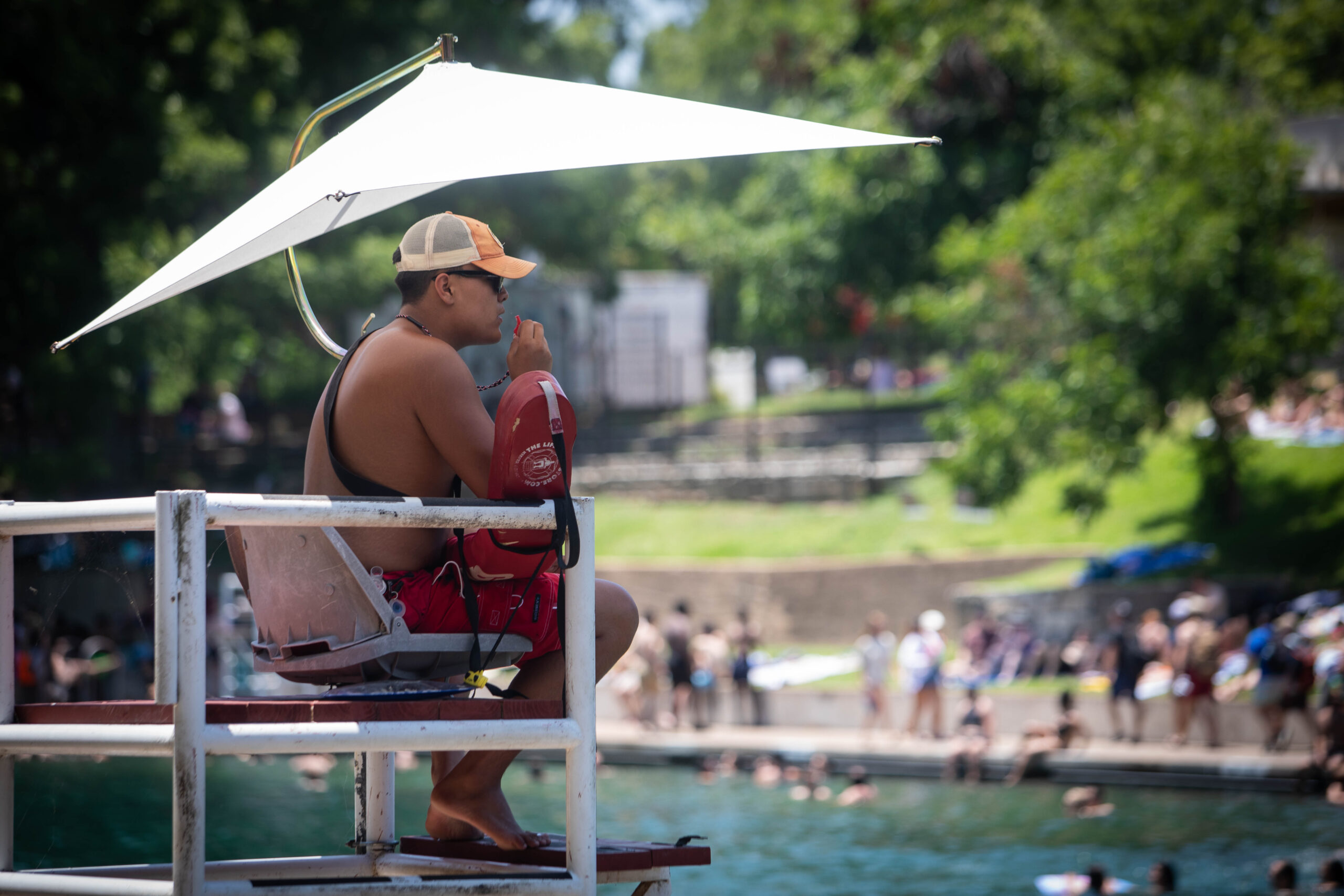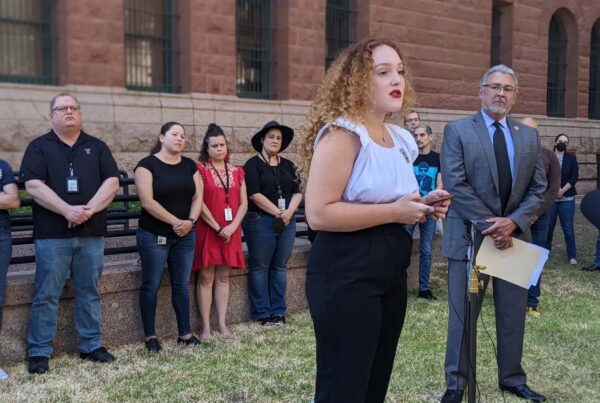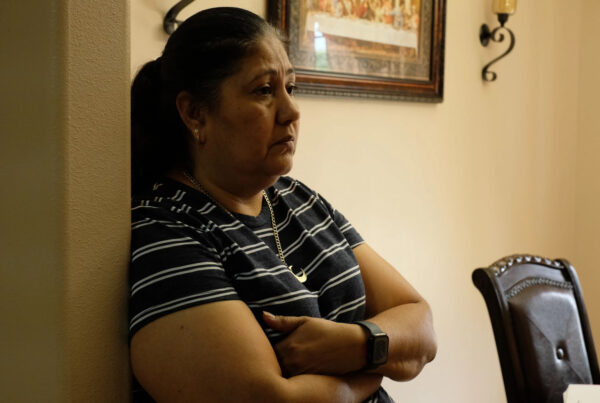Much of Texas is under what weather experts call a “heat dome,” which is when heat is trapped over a certain area, often leaving residents of that area in dangerous conditions. Texas is expected to reach or even pass its record high temperature of 120 degrees Fahrenheit, which was last hit in 1994. Just this past Friday on June 23, the Rio Grande Valley area got close, at 119 degrees Fahrenheit.
Of course, Texans are used to summer heat. Many know about the importance of drinking water, wearing sunscreen and staying in the shade. But experts say there’s a difference between normal hot temperatures and what we’ve experienced lately. And so higher levels of heat necessitate higher levels of care when it comes to heat conscientiousness.
Dr. Hilary Fairbrother, who is an emergency medicine physician with UTHealth Houston, spoke with Texas Standard about how to manage these sweltering temperatures. She said that she and other emergency medical responders have seen more cases of heat-related illnesses this summer, so no one should rest on their laurels when it comes to heat illness prevention.
“It’s certainly tested our patients in the ER,” Fairbrother said. “We’re seeing a lot more heat-related illness and I think it’s tested Texans in a different way. We’re used to the heat. We’re used to dealing with it. But this has really been a more dramatic summer than we are used to.”
Prevention as the first defense. Hydrate before you go outside
Staying inside as much as possible is recommended, but sometimes that just isn’t possible. For this reason, Fairbrother recommends preparing for the heat by being well-hydrated before ever going outside.
“If you have to be outside, especially for really longer than 15 minutes in this extreme heat, I do recommend aggressively hydrating before you ever go outside,” Fairbrother said. “So that means drinking plenty of water before you ever go into the heat to really prepare your body.”
» RELATED: Here’s how not to pass out in Texas’ triple-digit temps
What goes on your body is nearly as important as what goes in it
Next, before going outside, it’s important to bear in mind that what is going on your body is also important. While you will want your body to be covered to protect you from the sun, you’ll also want to make sure that the fabrics you’re choosing aren’t constricting and don’t absorb more of the sun’s rays.
“Be very mindful of what kind of clothes you’re wearing,” Fairbrother said. “We wear a lot of synthetic clothes these days and I know many people like to wear sports clothing that is quick dry and has other kinds of properties to it. But you need to make sure that the clothing covers as much of your skin as possible and is light colored. And cotton really does allow for the skin to breathe in a really wonderful way. So I always recommend to people that they wear clothes with as much cotton as possible.”
Trade in that visor for a cowboy hat
This may seem like a good opportunity to wear your favorite team’s baseball hat, but Fairbrother says that it only protects the front part of your face and leaves out other equally important parts of the body. And unfortunately, while a visor allows our head to breathe, our hair alone isn’t enough to protect us from the sun.
“I think that hats are wonderful,” Fairbrother said. “My favorite hat to wear is a baseball hat, and that, unfortunately, does not offer as much protection as a wider brimmed hat, such as a cowboy hat or a classic kind of wide-brimmed sunhat. The nice thing about those hats is that they have all around protection and they protect the head, but also the neck, the ears and the upper chest. So if you can, wear a bigger hat. Just try to make sure that if you are wearing a hat, that you also still wear sunscreen. There’s a lot of light reflected up towards your face. So even with a hat, sunscreen is still important.”
Once you’re outside, continue to hydrate
Drinking water is essential to preventing heat exhaustion and heat stroke. So it’s important to drink water as much as possible. It might be inconvenient if that causes you to head to the bathroom more often, but that gives you much-needed breaks from the sun anyways.
“If they need to be outside, then while outside stay hydrated,” Fairbrother said. “You have to drink the entire time and know that it’s going to be stressful for your body at about 15 minutes or more outside right now in these very hot temperatures. And then finally, if you start feeling sick, please get inside. Please get to the shade. Please rest and please drink some water. “
Once outside, be sure to monitor for signs of heat exhaustion or heat stroke
There are several signs of heat exhaustion that you can pay attention to to make sure that you or others get help as soon as possible. Fairbrother says to look out for the following signs to monitor for heat exhaustion:
“So as the body gets hot, we call it heat exhaustion,” Fairbrother said. “And that’s a person who’s really sweaty, who may be very flushed and red, who may be feeling dizzy, very thirsty, feeling like a racing heartbeat, woozy. In general, this person feels poorly, but they are awake. They are alert. They are conscious. That’s the best time to get help.”
Treating heat exhaustion early can help prevent a more serious condition – heat stroke. If intervention isn’t made early enough and you or another person are suffering from heat stroke, this could lead to dangerous consequences and therefore requires professional medical attention immediately.
“As heat exhaustion progresses, it progresses into something we call heat stroke, and then patients can really become unconscious or altered, meaning they just don’t know where they are,” Fairbrother said. “They may seem intoxicated. People might have a seizure and they actually stop sweating, though they are usually still very red or flushed in appearance. And this is really dangerous.”
What to do if heat exhaustion or heat stroke sets in
Sometimes even with our best efforts, heat-related illnesses are inevitable, especially if going outside in these extreme temperatures. So be on the lookout for these signs of heat exhaustion and heat stroke.
If signs and symptoms are pointing to heat exhaustion, here is what Fairbrother says you should do:
“Get in the shade, get inside, get water, rest if you’re exerting yourself and hopefully cool down. If the skin is not wet, you can always apply water to clothes or to the skin. And a fan is always really helpful.”
In the event of heat stroke, the best thing that Fairbrother says to do is call 911 and get immediate medical attention.













